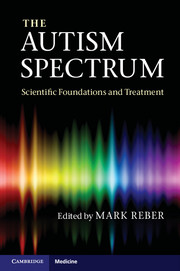Book contents
- Frontmatter
- Contents
- List of Abbreviations
- List of Contributors
- Preface
- Section 1 What We Know about Autism and How We Know It
- Section 2 Assessing and Treating Children with Autism Spectrum Disorders
- Chapter 7 Autism screening and diagnostic evaluation
- Chapter 8 Educational treatments for children with ASDs
- Chapter 9 Habilitative treatments for children with ASDs
- Chapter 10 Behavioral treatments for children with ASDs
- Chapter 11 Medication and nutritional treatments for children with ASDs
- Section 3 Assessing and Treating Adults with Autism Spectrum Disorders
- Index
- Plate Section
- References
Chapter 8 - Educational treatments for children with ASDs
from Section 2 - Assessing and Treating Children with Autism Spectrum Disorders
Published online by Cambridge University Press: 05 November 2012
- Frontmatter
- Contents
- List of Abbreviations
- List of Contributors
- Preface
- Section 1 What We Know about Autism and How We Know It
- Section 2 Assessing and Treating Children with Autism Spectrum Disorders
- Chapter 7 Autism screening and diagnostic evaluation
- Chapter 8 Educational treatments for children with ASDs
- Chapter 9 Habilitative treatments for children with ASDs
- Chapter 10 Behavioral treatments for children with ASDs
- Chapter 11 Medication and nutritional treatments for children with ASDs
- Section 3 Assessing and Treating Adults with Autism Spectrum Disorders
- Index
- Plate Section
- References
Summary
This chapter will review several topics in the educational treatment of children with autism spectrum disorders. The discussion will provide a broad overview of preschool and school-based interventions, some of which will be addressed in greater detail in the next two chapters. Specific topics to be covered are early intervention services, special education for children of school age, comprehensive and focused interventions that are used in the classroom, transition to adult services, and inclusion of ASD children in regular education.
Early intervention services (birth until age 3)
When a child is diagnosed with autism or a developmental delay, parents endeavor to find educational services as early as possible to address their child’s needs. Most European countries and the United States offer educational services to developmentally delayed children and their families prior to school age. The purpose of early educational services is to identify children who have, or are at risk for, a specific disability or general developmental delay, and to design a program to meet their needs before the typical start of public educational services. Research has demonstrated that children who receive early special services have better outcomes, and families who are provided with early support are better equipped to advocate for their children later in life (Guralnick, 1997). The delivery of these services, known as “Early Intervention Services” or “Early Childhood Intervention,” can differ among countries. Some countries have center-based programs (such as Head Start in the US), home-based programs (such as Portage in the UK), or a mixed program (such as Lifestart in Australia). Most of these countries have services beginning at birth; however, parents often need to seek referral to those systems through their medical doctors. Most programs are funded entirely by the government; however, some programs may require fees for specific services (“Special Education,” 2010).
- Type
- Chapter
- Information
- The Autism SpectrumScientific Foundations and Treatment, pp. 201 - 216Publisher: Cambridge University PressPrint publication year: 2012



